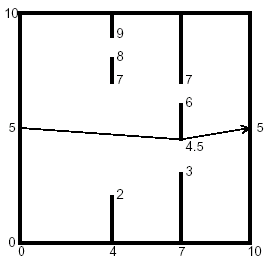链接:http://poj.org/problem?id=1556
The Doors
| Time Limit: 1000MS | Memory Limit: 10000K | |
| Total Submissions: 6216 | Accepted: 2495 |
Description
You are to find the length of the shortest path through a chamber containing obstructing walls. The chamber will always have sides at x = 0, x = 10, y = 0, and y = 10. The initial and final points of the path are always (0, 5) and (10, 5). There will also be from 0 to 18 vertical walls inside the chamber, each with two doorways. The figure below illustrates such a chamber and also shows the path of minimal length.


Input
The input data for the illustrated chamber would appear as follows.
2
4 2 7 8 9
7 3 4.5 6 7
The first line contains the number of interior walls. Then there is a line for each such wall, containing five real numbers. The first number is the x coordinate of the wall (0 < x < 10), and the remaining four are the y coordinates of the ends of the doorways in that wall. The x coordinates of the walls are in increasing order, and within each line the y coordinates are in increasing order. The input file will contain at least one such set of data. The end of the data comes when the number of walls is -1.
2
4 2 7 8 9
7 3 4.5 6 7
The first line contains the number of interior walls. Then there is a line for each such wall, containing five real numbers. The first number is the x coordinate of the wall (0 < x < 10), and the remaining four are the y coordinates of the ends of the doorways in that wall. The x coordinates of the walls are in increasing order, and within each line the y coordinates are in increasing order. The input file will contain at least one such set of data. The end of the data comes when the number of walls is -1.
Output
The output should contain one line of output for each chamber. The line should contain the minimal path length rounded to two decimal places past the decimal point, and always showing the two decimal places past the decimal point. The line should contain no blanks.
Sample Input
1 5 4 6 7 8 2 4 2 7 8 9 7 3 4.5 6 7 -1
Sample Output
10.00 10.06
////////////////////////////////////////////////////////////////////
这题处理起来挺难的,要把输入的点存到图里,用Dijkstra求出最短路径,存图的过程是,判断任意两点连成的线,横坐标不能相同,并且如果,横坐标与线上的横坐标不相同,就要判断是否相交,相交则行不通
否则存图,用Dijkstra搜出最短的路径即可
还有,要注意细节

1 #include <stdio.h> 2 #include <string.h> 3 #include <stdlib.h> 4 #include <iostream> 5 #include <math.h> 6 #include <algorithm> 7 8 #define eps 1e-6 9 #define INF 1000000000 10 typedef struct point 11 { 12 double x,y; 13 }point; 14 15 typedef struct beline 16 { 17 point st,ed; 18 }beline; 19 20 using namespace std; 21 22 point p[1005]; 23 double mp[1005][1005]; 24 double d[1005]; 25 int visit[1005]; 26 27 bool dy(double x,double y){ return x > y+eps; } 28 bool xy(double x,double y){ return x < y-eps; } 29 bool dyd(double x,double y){ return x > y-eps; } 30 bool xyd(double x,double y){ return x < y+eps; } 31 bool dd(double x,double y){ return fabs(x - y)<eps; } 32 33 double crossProduct(point a,point b,point c) 34 { 35 return (c.x-a.x)*(b.y-a.y)-(c.y-a.y)*(b.x-a.x); 36 } 37 double Dist(point a,point b) 38 { 39 return sqrt((a.x-b.x)*(a.x-b.x)+(a.y-b.y)*(a.y-b.y)); 40 } 41 42 bool onSegment(point a,point b,point c) 43 { 44 double maxx=max(a.x,b.x); 45 double maxy=max(a.y,b.y); 46 double minx=min(a.x,b.x); 47 double miny=min(a.y,b.y); 48 if(dd(crossProduct(a,b,c),0.0)&&dy(c.x,minx)&&xy(c.x,maxx) 49 &&dy(c.y,miny)&&xy(c.y,maxy)) 50 return true; 51 return false; 52 } 53 54 bool segIntersect(point p1,point p2,point p3,point p4) 55 { 56 double d1 = crossProduct(p3,p4,p1); 57 double d2 = crossProduct(p3,p4,p2); 58 double d3 = crossProduct(p1,p2,p3); 59 double d4 = crossProduct(p1,p2,p4); 60 if(xy(d1*d2,0.0)&&xy(d3*d4,0.0)) 61 return true; 62 if(dd(d1,0.0)&&onSegment(p3,p4,p1)) 63 return true; 64 if(dd(d2,0.0)&&onSegment(p3,p4,p2)) 65 return true; 66 if(dd(d3,0.0)&&onSegment(p1,p2,p3)) 67 return true; 68 if(dd(d4,0.0)&&onSegment(p1,p2,p4)) 69 return true; 70 return false; 71 } 72 73 void Dijkstra(int n) 74 { 75 int i,y; 76 memset(visit,0,sizeof(visit)); 77 for(i=0; i<n; i++) 78 d[i] = mp[0][i]; 79 d[0] = 0; 80 for(i=0; i<n; i++) 81 { 82 int m=INF,x; 83 { 84 for(y=0; y<n; y++) 85 { 86 if(!visit[y] && d[y]<=m) 87 { 88 m = d[ x = y ]; 89 } 90 } 91 visit[x]=1; 92 for(y=0; y<n; y++) 93 { 94 if(!visit[y] && d[y] > d[x]+mp[x][y]) 95 { 96 d[y] = d[x] + mp[x][y]; 97 } 98 } 99 } 100 } 101 } 102 103 int main() 104 { 105 int n,m,i,j,k,t; 106 double a,b,c,d1,e; 107 beline li[10005]; 108 beline tmp; 109 p[0].x=0;p[0].y=5;//freopen("in.txt","r",stdin); 110 while(scanf("%d",&n)!=EOF && n!=-1) 111 { 112 for(i=0; i<1005; i++) 113 for(j=0; j<1005; j++) 114 mp[i][j] = INF; 115 int cas=1,css=0; 116 for(i=0; i<n; i++) 117 { 118 scanf("%lf%lf%lf%lf%lf",&a,&b,&c,&d1,&e); 119 li[css].st.x=a; 120 li[css].st.y=0; 121 p[cas].x=a; li[css].ed.x=a; 122 p[cas++].y=b;li[css++].ed.y=b; 123 p[cas].x=a; li[css].st.x=a; 124 p[cas++].y=c;li[css].st.y=c; 125 p[cas].x=a; li[css].ed.x=a; 126 p[cas++].y=d1;li[css++].ed.y=d1; 127 p[cas].x=a; li[css].st.x=a; 128 p[cas++].y=e;li[css].st.y=e; 129 li[css].ed.x=a; 130 li[css++].ed.y=10; 131 } 132 p[cas].x=10.0;p[cas].y=5.0; 133 for(i=0; i<=cas; i++) 134 { 135 for(j=i+1; j<=cas; j++) 136 { 137 int ok=0; 138 for(k=0; k<css; k++) 139 { 140 if(dd(p[i].x,p[j].x)||!dd(p[i].x,li[k].st.x)&&!dd(p[j].x,li[k].st.x)&&(segIntersect(p[i],p[j],li[k].st,li[k].ed))) 141 { 142 ok=1; 143 break; 144 } 145 } 146 if(!ok) 147 { 148 mp[j][i] = mp[i][j] = Dist(p[i],p[j]);//printf("%d %d %lf ^^\n",i,j,mp[i][j]); 149 } 150 } 151 } 152 Dijkstra(cas+1); 153 printf("%.2lf\n",d[cas]); 154 } 155 return 0; 156 }



